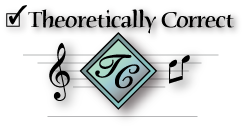The Pentatonic Scale in Jazz Fusion
Guitarist Scott Henderson demonstrates a shape shifting trick
for improvising with the modes of the major pentatonic scale
In the following instructional video Scott Henderson plays some super crazy jazz fusion improvisation. Additionally he roughly outlines a wonderful and welcomed "recycle-yer-riff" concept.
The idea is simple. Once you know a particular guitar finger shape for the minor pentatonic scale (1, b3, 4, 5 b7)* you can use it to create three distinct, sophisticated sounds that work atop a given harmonic context (in this case, on Henderson's video, the context is a Bm7 vamp.) Here we'll take detailed look at the concept Henderson expressed. Then we'll examine it from a unified perspective.
It's great that Henderson encourages people to shift fingering shapes along the neck to produce different harmonic effects, without mindful analysis of the underlying relationships. With this intuitive approach to improvisation (a shortcut for applying "some kind" of a different scale) people can play amazing things without fully understanding the foundational concepts. So here's to that!
Henderson compellingly outlines this reasonably well known trick which allows you to effectively use and reuse a single physical shape, to good effect, without any heavy theoretical lifting. First I'll recap Henderson's point, and then we'll dig a little deeper and see what's really going on.
Here's the B minor pentatonic fingering (1, b3, 4, 5 b7) that Henderson plays at 1:14 in the video, where he says, "Everybody knows this shape."
You can skip the introductory portion of the video and start viewing at 1:14. And please note, you can play this video at half speed if you opt in to youTube's HTML5 trial:
Sure is cool ... but what is it?
After watching this tutorial my first reaction was "I wanna try that!"
My next thought was, "I'd like to know what scales or modes he's playing! Henderson never really explained what's going on beneath the hood. In other words, he never stated the names or formulas of those two other scales. He just makes vague statements like, 'What people don't know is that you can move that shape to different areas and get different sounds.'" For instance, at 3:50, Henderson states that the other scales he plays are the "Same exact shape, but you're just getting a different series of sounds." Immediately following, to our disadvantage, he's led off he topic by the interviewer and for the duration of the video he focuses on a 7/8 over 4/4 rhythmic trick. Thus we hear nothing more regarding the scales, and we never receive the promise of the title of the video: "Secrets of the Pentatonic Scale."
Modal underpinnings
Somehow I got a hunch that the underlying magic might be a modal phenomenon. So I set out to analyze the sounds and hunt down the unnamed scales or modes ... and an interesting journey it was. I used Sound Thinking to help me figure it out. In this article I'll do my best to cover that unspoken portion of the topic.
If you're still with me, I'll mention up front, yes indeed, there is a modal relationship at the core of this trick.
I use a similar modal trick with various styles of music, including blues, swing-jazz and bluegrass. You can freely switch between an A blues scale and an F# blues scale on many songs. They because they work so well you needn't exert much caution. Just let it fly.
See for yourself. If we look at the F# blues, from an A perspective, we find that it's the 2nd mode of the A blues scale. I call it A Relative Blues. You can see relationship between F# blues and A Relative Blues here in Sound Thinking.
The Minor Pentatonic shape
As mentioned, Henderson starts out playing a B minor pentatonic scale (1, b3, 4, 5, b7). It's worth noting that this is the same as 5th mode of the major pentatonic scale (1, 2, 3, 5, 6) rooted on B. If you didn't look early, please read the footnote about pentatonic names.
Henderson uses and reuses this "minor pentatonic" shape, locating it first on the 7th fret; then relocating it up to the 9th fret; and lastly down to the 2nd fret. As he explains in the video, he's playing B, C# and F# minor pentatonic respectively, over the constant harmonic backdrop of a Bm7 chord.
While this is an accurate description, it fails to embrace the grammatical rules that accompany the musical notion of tonal center. There is a unified viewpoint that leaves us more informed. Granted it's a slightly more complex viewpoint, but it's a valuable viewpoint because it honestly explains the sounds generated. In a sense, it's a less geocentric view of the tonal universe.
Nevertheless, Henderson's point is simple AND significant. He generated these modes the easy way, by using the original B minor pentatonic fingering in different fretboard locations. No further mental framework required.
All this shape shifting viewed from a B tonal center
Here's a coherent overview of Henderson's trick explained from the single perspective of a B tonal center.
- First he plays B minor pentatonic (1, b3, 4, 5, b7) — aka the 5th mode of the Major pentatonic (1, 2, 3, 5, 6)
- Then he's plays B major pentatonic (1, 2, 4, 5, 6) — aka, the 4th mode of the Major pentatonic scale (the same sound and notes as C# minor pentatonic.)
- Then he's plays B dominant pentatonic (1, 2, 4, 5, b7) — aka, the 2nd mode of the Major pentatonic scale (the same sound and notes as F# minor pentatonic.)
Click here to see what these modes look like graphically in Sound Thinking, when pictured from the perspective of a B tonal center. Sound Thinking provides an interactive view of the modes depicted below:
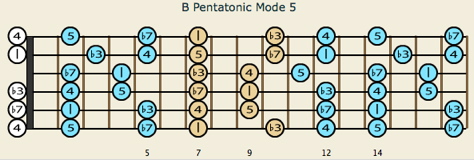
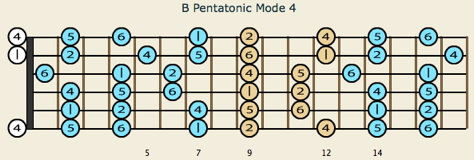
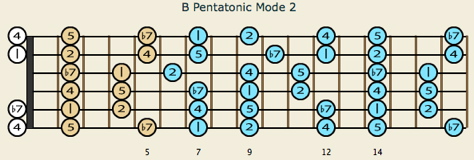
What about Henderson's reference to the A major scale?
I'm not sure why Henderson likens these modes to the A major scale. He states, "The technical reason [this works] is because the notes of the B minor pentatonic scale come from the A major scale; these pentatonic shapes, the B minor pentatonic shape, the C# minor pentatonic shape, and the F#minor pentatonic shape, all contain notes from the A major scale."
Granted, the notes of his three shapes (and these three modes) are are indeed found in the A major scale ... but that doesn't really explain or define the sounds we're hearing as he shifts the shapes around. And if we name this scale according to an A tonal center we get an A dorian scale with no 3 or 7. What's simple about that?
Taking it further, and wrangling those other modes
Here's a highly recommended exploration that Henderson didn't touch on.
Learn to play those modes rooted on the 7th fret of the E string, without shifting. Click here to see how. This will give you a real foothold on the underlying theory.
As you can see below, as you compare modes from left to right, first we lose the b3 and b7, so we've switched from minor pentatonic to major pentatonic.
- The difference between mode 5 (the initial minor pentatonic scale): there's a 2 instead of a b3
- The difference between Mode 2 and Mode 4: there's a 6 instead of a b7
So here are the modes, renamed:
- Mode 5 = B minor pentatonic, Mode 4 = C# minor pentatonic, Mode 2 = F# minor pentatonic
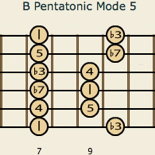
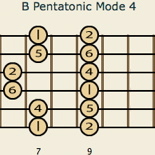
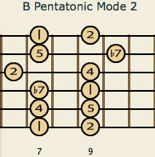
A de-minor-ification of the Pentatonic modes
In the next demonstration we switch the order of scales that Henderson plays, just to make an interesting point. If we reorder the modes as shown below, mode 5, 2, and 4, we find only a single note difference between each pair.
As you compare modes from left to right, first we lose the b3; then the b7. So each fingering is one step less minor, less bluesy (... kinda of like going through the modes of the major scale in this order: Aeolean, Dorian, Mixolydian, Ionian — first we lose the b6, then the b3, then the b7; the journey is one note less minor each step, ending up at major/Ionian.
- The difference between mode 5 (the initial minor pentatonic scale) and mode 2: in mode 2 there's a 2 instead of a b3
- The difference between Mode 2 and Mode 4: in mode 4 there's a 6 instead of a b7
- Reasonable names for Mode 2 are: Dominant Pentatonic or Suspended Dominant pentatonic



A comment from a viewer
youTube member "grb321" left this comment about the video:
"If you're playing over a Bm7 chord, then the notes of the C# minor pentatonic function as 2, 4, 5, 6, and 1, and the notes of the F# minor pentatonic function as 5, 7, 1, 2, and 4. (Of course, the notes of the B minor pentatonic function as 1, 3, 4, 5, and 7.) So all those pentatonic fingers work well over a Bm7 chord."
I haven't checked the math. But even if this is true, I don't get the point.
Another author's hit on all this
Now that I've completed this article I stumbled on another author's treatment of the subject.
Experts and amateurs don't always explain matters logically or fully...
This video is funny. Don't ya love the way people attempt to explain things: "The easiest way to find the major pentatonic is to play the minor pentatonic scale (ambiguous advice, because there are more than one) and shift the fingering down three frets."
Bobby McFerrin on the Pentatonic
Let's end on an upbeat by watching Bobby McFerrin's delightful demonstration of the pentatonic scale. This occurred at a scientific conference where they were exploring the concept of expectations. Please note, McFerrin was not demonstrating to an audience of trained musicians.
Use Sound Thinking for free ... here at Theoretically Correct!
Use Key Switch to transpose chords in song sheets
*Pentatonic Names
NOTE: The term "minor pentatonic" is bandied about loosely. And there is no consensus on pentatonic names:
- there are two scales called major pentatonic: 1, 2, 3, 5, 6 and 1, 2, 4, 5, 6
- three called minor pentatonic: 1, 2, b3, 5, 6; 1, b3, 4, 5, b7 and 1, b3, 4, 5, 6
... and that's about as specific as people get. There are some ethnic names too, but in order to to accurately reference pentatonic scales it's best to spell them by formula, or refer to them by mode number.
Keep in mind that pentatonic simply means five notes per octave. I believe there are hundreds possibilities, though many may not offer much musical merit. I think the math for the possible combination calculation is handled by the formula 12!/(5!*7!) which equals 792 possible pentatonic scales.
Rather for looking for random pentatonics, better question would be, "How many pentatonics exist that are a combination of whole steps, half steps, 1.5 steps ... with no more than three adjacent chromatic tones?"

